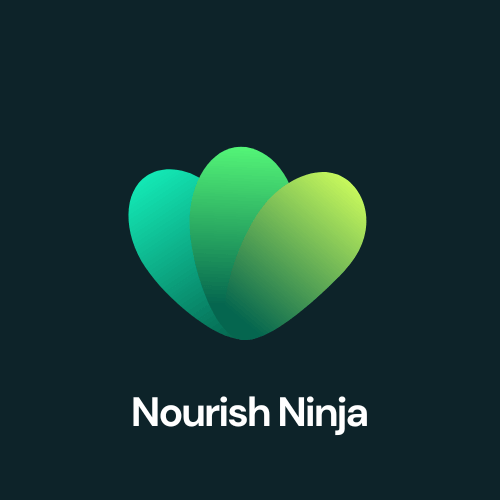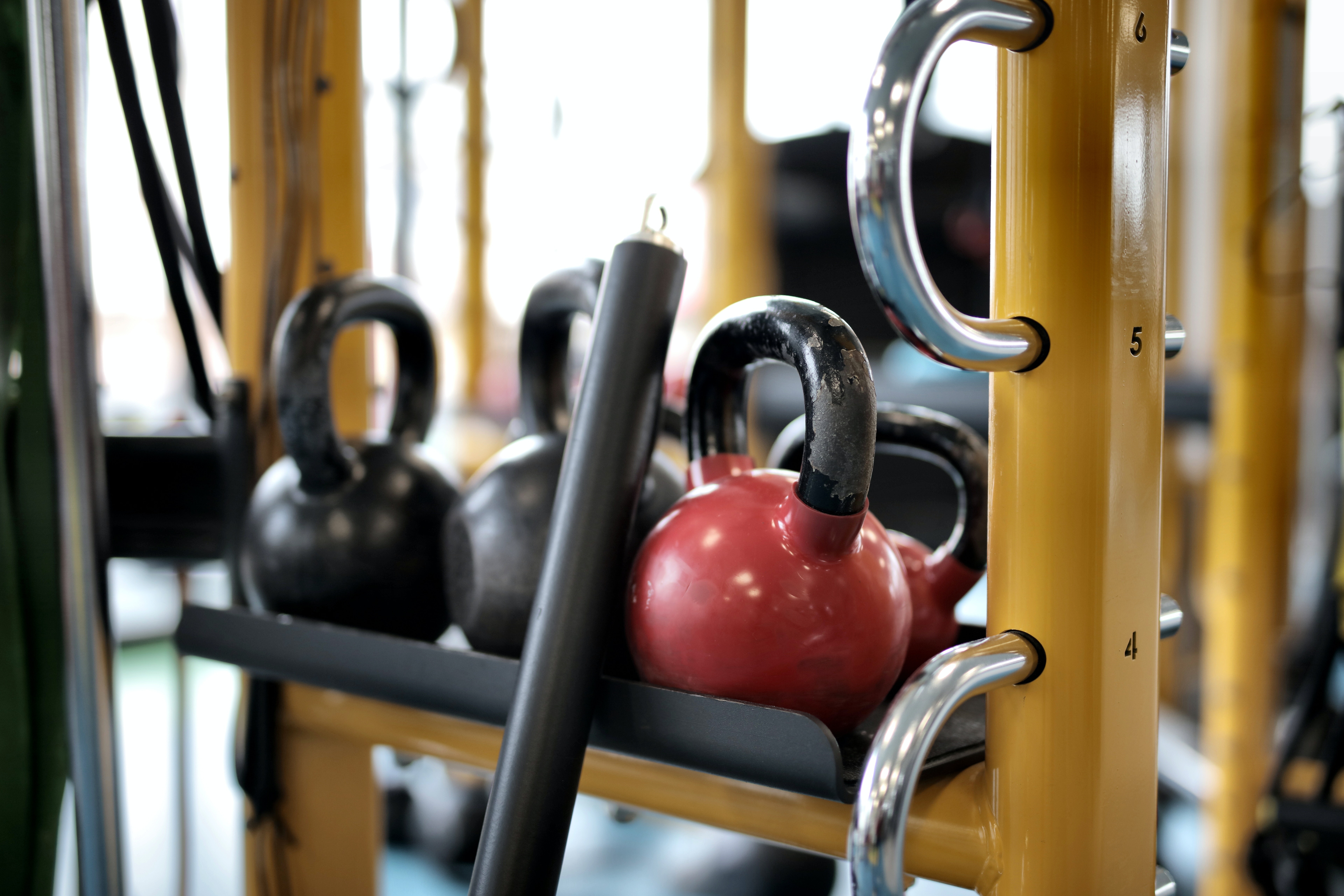Are you eager to build up your leg muscles and improve your level of fitness? The best kettlebell leg workout is the answer. For working the muscles in your legs, such as your quadriceps, hamstrings, glutes, and calves, kettlebells are a versatile and powerful tool.
This type of workout is made to push and strengthen your lower body, regardless of your level of fitness or knowledge. Ready yourself to reach all of your goals and build strong, toned legs with this exciting kettlebell exercise.
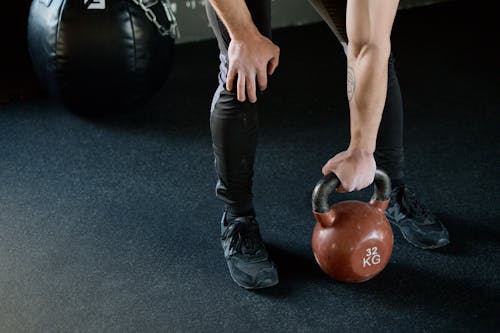
Kettlebell Leg Workout
1. Kettlebell Swings
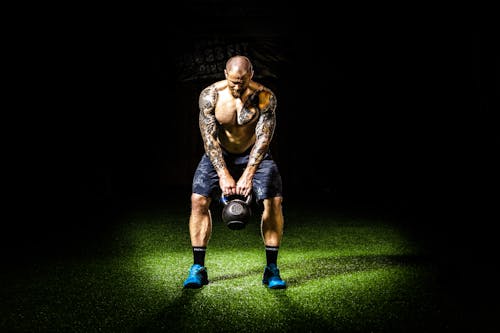
Kettlebell swings are an active exercise that strengthens your core, legs, and hips. For effective kettlebell swings, stick to these steps:
a.The kettlebell should be held in both hands while you stand with your feet shoulder-width apart.
b. Lower the kettlebell between your legs while maintaining a straight back, engaging your core, and hip hinges.
c. Using the momentum created by your lower body, drive your hips forward and swing the kettlebell up to your chest.
d. Maintain control of the downward swing and do the action as many times as needed.
e. Pay attention to keeping a controlled and fluid motion while utilising the strength in your legs and hips.
Kettlebell swings are known for their heart-health advantages, the development of explosive power, and posterior chain strength. They can be utilised as a stand-alone exercise or as part of conditioning sessions.
2. Kettlebell Squats
Squats with a kettlebell are good exercises to target the muscles in your thighs, hips, and glutes. How to do kettlebell squats is as follows:
a. Using both of your hands, hold the kettlebell by the handle, letting it hang in front of you.
b. Keep your toes slightly turned out and spread your feet shoulder-width apart.
c. Sit back into a chair by bending your knees and hips to lower your back.
d. When you’re lowering yourself into the squat posture, keep your chest up and your weight on your heels.
e. To return to the beginning position, press through your heels, then repeat for the required number of repetitions.
Squats with a kettlebell help increase the flexibility, stability, and strength of the lower body. You can execute these by holding a single kettlebell in the goblet posture or two kettlebells stacked.
3. Kettlebell Deadlifts
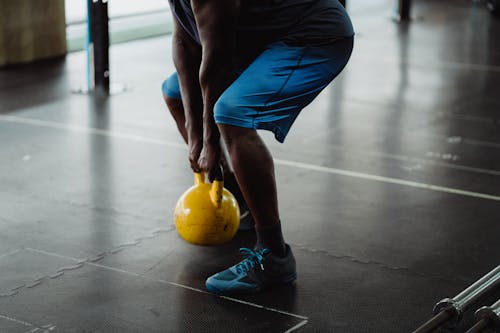
The muscles in your hamstrings, glutes, and lower back are the ones that are worked out during a kettlebell deadlift. Kettlebell deadlifts are performed by following these steps:
a. Stand with your feet hip-width apart and place the kettlebell on the ground in front of you.
c. Slightly bend your knees and bend at the hips to hold the kettlebell in both hands.
c. Stand tall while lifting the kettlebell, maintaining a straight back and a tight core.
d. Throughout the exercise, keep your spine neutral and try not to round or arch your back.
e. Controllably lower the kettlebell back to the starting position and perform the exercise once more.
Exercises like kettlebell deadlifts are good for strengthening the posterior chain, improving hip hinge mechanics, and fostering good lifting techniques.
4. Lunges with a kettlebell
Lunges with a kettlebell are a wonderful exercise for working your glutes, hamstrings, and quads. To make kettlebell lunges, do the following:
Hold a kettlebell in each hand by your sides while you stand with your feet hip-width apart.
a. Make sure your knee is directly over your ankle as you advance with one foot.
b. Bending both knees will allow you to lower your body till your back knee is barely off the floor.
c. Return to the beginning posture by pressing through your front heel, then repeat with the other leg.
d. Lunges should be performed with alternate legs for the necessary amount of repetitions.
Strength, balance, and stability in the lower body are all enhanced by kettlebell lunges. Depending on your fitness level and goals, you can modify them by using lighter or heavier kettlebells.
5. Kettlebell Step-Ups
Step-ups with a kettlebell are wonderful exercises for your quadriceps, hamstrings, and glutes in the lower body. As an example, consider how to perform kettlebell step-ups:
a. Stand facing a sturdy bench or step while holding a kettlebell in each hand.
b. When placing one foot there, make sure your complete foot is in contact with the bench or step.
c. Drive through your heel to raise your body up onto the step or bench.
d. Step back down steadily, then perform the exercise with the same leg as many times as necessary.
e. After swapping, carry out the same exercise on the other leg.
Kettlebell step-ups help increase power in your lower body, strengthening your lower body, and enhancing balance. By altering the weight of the kettlebells and the height of the bench or step, you may alter the challenge of this exercise.
6. Kettlebell Turkish Get-Ups
Turkish get-ups with a kettlebell are a demanding and all-encompassing workout that develops stability and coordination while working a variety of muscle groups. To complete a kettlebell Turkish get-up, follow these steps:
a. Take a kettlebell in one hand and raise your arm above your head while lying on your back.
b. For stability, bend your opposite leg to the same side as the kettlebell while holding out your other arm.
c. Keep the kettlebell locked out above your shoulder while rolling onto your side with your free hand.
d. Get up into a sitting position by placing your free hand on the floor.
e. From the seated posture, sweep your leg through and bridge your hips up until you are kneeling with the kettlebell still raised above your head.
f. As you keep the kettlebell in your overhead posture, stand up from the kneeling position.
g. To get back to the starting position, reverse the steps.
h. With each repetition, switch sides and repeat the action on the opposite side.
Turkish get-ups with a kettlebell put stress on your core, shoulders, hips, and stability muscles. Because they demand control and coordination throughout the whole movement, they are a great exercise for developing general strength and stability.
7. Kettlebell Single-Leg Deadlifts
Hamstrings, glutes, and stabiliser muscles in the hips and core are worked out unilaterally during kettlebell single-leg deadlifts. Kettlebell single-leg deadlift instructions are as follows:
a. Holding a kettlebell in one hand, stand with your feet hip-width apart.
b. Put all of your weight on one leg, bending the knee just a little.
c. With your opposite leg extended straight behind you for balance, lean forward at the hips.
d. As you lower the kettlebell, keep your spine neutral and bend your standing leg just a little bit.
e. Engage your glutes and push through your standing heel to get back to the beginning position once you feel a stretch in your hamstrings.
f. Before moving to the other leg, finish the appropriate number of repetitions on the first leg.
Single-leg deadlifts with kettlebells can aid with balance, stability, and unilateral strength. They are an effective exercise for developing lower body strength and stability because they also target the posterior chain muscles, such as the hamstrings and glutes.
8. Kettlebell Thrusters
A dynamic and all-body exercise called a kettlebell thruster combines an overhead press with a squat. How to do kettlebell thrusters is as follows:
a. Put your feet shoulder-width apart and hold a kettlebell close to your chest in the rack position.
b. Keep your chest up and your core engaged, lower into a squat by bending your knees and pushing your hips back.
c. To get out of the squat, drive through your heels forcefully and stretch your hips and knees.
d. Utilising your momentum, press the kettlebell overhead while fully extending your arms as you rise to the top of the squat.
e. As you begin the subsequent set of squats, lower the kettlebell back to the rack position.
f. The movement should be repeated as many times as needed.
Kettlebell thrusters are a wonderful exercise for improving overall strength, power, and conditioning because they work your legs, core, shoulders, and arms.
9. Kettlebell Bulgarian Split Squats
The quads, glutes, and hamstrings are the main areas of the lower body that are worked by kettlebell Bulgarian split squats. Here is how to carry out Bulgarian split squats with a kettlebell:
a. To begin, step forward with one foot and place your rear foot’s top on a bench or other elevated surface behind you.
b. Keep a kettlebell stacked on the side opposite the front leg.
c. By bending your front leg and bringing your rear knee down towards the floor, you can lower your body.
d. Make sure your front knee doesn’t go past your ankle and remains in line with it.
e. For a startling return to the starting position, drive through your front heel.
f. Before switching legs, perform the desired number of reps of the exercise.
Strength, balance, and stability in the lower body are all enhanced with kettlebell Bulgarian split squats. Additionally, they offer a unilateral training stimulus that specifically targets each leg.
10. Kettlebell Renegade Rows
Renegade rows with a kettlebell are a difficult workout that strengthens the back, shoulders, and core. How to do kettlebell renegade rows is as follows:
a. Start in a high plank stance with your hands shoulder-width apart holding two kettlebells.
b. Keep your body in a straight line from head to toe by engaging your core.
c. Row one kettlebell towards your chest, minimising rotation and maintaining a stable body.
d. Return the kettlebell to the floor after finishing the row, then do the opposite side.
e. Maintaining appropriate plank form, keep switching rows.
Kettlebell renegade rows test the stability and control of the core while engaging the muscles in the upper body, such as the back and shoulders.
Learn to select a suitable kettlebell weight that pushes you but doesn’t interfere with your form. Use the right form for each exercise, and concentrate on using the specific muscles that are being worked. Increase the number of repetitions and sets gradually as your strength and stamina develop.
Kettlebell Leg Exercises for Runners
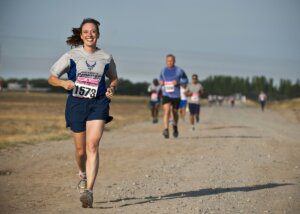
With our specific running-specific kettlebell leg exercises, you can improve your running efficiency and strengthen your legs. For better leg strength, stability, and stamina, include lunges, kettlebell swings, and goblet squats in your workout program.
These dynamic workouts focus on important running muscles like the quads, hamstrings, glutes, and calves to improve your running form and lower your chance of injury.
Increase your power and quickness while running on the track or trails by including kettlebell leg exercises in your daily routine.
How to Train Leg with Kettlebell
Our detailed instructions on how to do kettlebell leg training will help you maximize the potential of your legs. Learn how to work every major leg muscle with exercises including kettlebell squats, lunges, deadlifts, and step-ups.
To push yourself and attain the best outcomes, learn good form, technique, and variations. Improve your stability, leg strength, and lower body endurance by strengthening your legs.
Our kettlebell leg training advice will enable you to intensify your leg exercises, regardless of your level of fitness. Prepare to use the force of kettlebells to form and tone your legs like never before.
Kettlebell Leg Exercises Reddit
Join the Reddit revolution for kettlebell leg exercises! Find a variety of kettlebell leg exercises shared by professionals and fitness enthusiasts.
Explore several workouts and training programs to build and tone your legs, from kettlebell squats and lunges to kettlebell swings and deadlifts.
Take your leg workouts to the next level by drawing inspiration from the community’s advice, methods, and personal experiences.
The Reddit community is a great resource for including kettlebell leg workouts in your fitness routine, whether you’re new or an experienced athlete.
Improve your leg workouts and make friends on Reddit with people who share your interest in kettlebell exercises.
How to use a Kettlebell for Legs?
With these powerful workouts, you can maximize the benefits of kettlebell training for your legs.
The kettlebell squat, a complex exercise that works your quads, hamstrings, and glutes, is a good place to start.
To further enhance stability, balance, and total leg strength, go on to the kettlebell lunge.
Swinging a kettlebell will work your entire lower body and increase your explosive power.
The kettlebell deadlift, which strengthens your posterior chain, should not be ignored.
Use these exercises as part of your leg workouts to push yourself and get amazing results.
Kettlebell training can enhance your leg workouts if done properly and regularly.
Ready to increase the quality of your leg workouts with kettlebells’ flexibility?
Safety Considerations for Kettlebell Leg Workout
How to Properly Perform Kettlebell Leg Workout
Using the right form and technique will protect your safety and increase the effectiveness of your kettlebell leg workout. Follow the guidelines below:
Begin with an appropriate kettlebell weight
During the workouts, pick a weight that enables you to keep perfect technique. Increase the weight gradually as your strength and form get better.
Maintain a neutral spine
Throughout the exercises, keep your back straight and your abs tight. Do not round or arch your back as this can result in injury or strain.
Pay close attention to where your feet should be placed
set them shoulder-width apart or however far apart is necessary for each exercise. Make sure your feet are firmly planted on the ground and that your weight is spread equally.
Use the right muscles
While doing each exercise, focus on using the particular leg muscles that are being worked. For example, when performing squats, concentrate on engaging your quadriceps, hamstrings, and glutes to propel the movement.
Keep control of the kettlebell
During the workout, keep control of the kettlebell. Avoid swinging or jerking motions since they can cause control issues or muscle fatigue.
What to Avoid During Kettlebell Leg Workout
while performing kettlebell leg exercises, you should avoid the following steps :
Over-exertion
Overe exertion can result in muscle strains, joint pain, or other medical conditions. Pushing yourself too hard or using too large weights can do the same. Follow the signals from your body and move forward at a rate appropriate for your level of fitness.
Inadequate breathing
Maintain a regular breathing pattern while performing the exercises, exhaling during the exertion phase and inhaling during the relaxation period. Holding your breath can raise blood pressure and put a burden on your cardiovascular system, so try to avoid it.
Skipping the warm-up and cool-down phases
Always start your leg workout with a full warm-up to get your muscles and joints ready for the exercises. Likewise, end with a cooldown to stretch and unwind your muscles. Bypassing these measures, you run a higher risk of getting hurt.
Improper kettlebell handling
Take care when using kettlebells to prevent losing them or accidentally injuring yourself or others. At all times, grasp the kettlebell firmly with a controlled grip.
Ignoring pain or discomfort
If you encounter sudden pain, joint ache, or any other strange sensations while performing the exercises, stop right away. Consult a medical expert if the pain continues or gets worse.
Always keep safety first when doing out with a kettlebell on your legs. You can enjoy the advantages of this demanding yet effective training method while reducing the risk of injury by using the right weights, maintaining perfect form, and paying attention to your body.
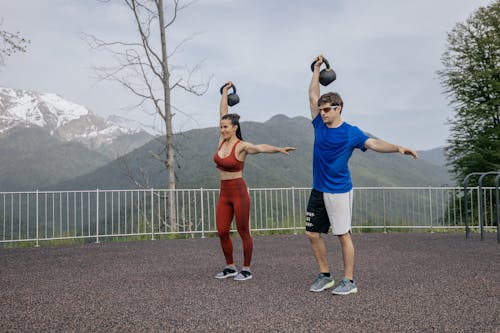
Warm-up exercises for a kettlebell leg workout
Squats
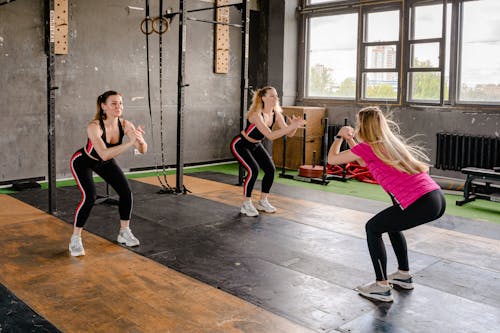
Squat exercises are effective warm-up exercises because they work several leg muscles. For performing squats as part of your warm-up, follow these steps:
a. Put both your feet shoulder-width apart and point your toes slightly outward as you stand.
b. When you lower your body by bending your knees and hips, engage your core and maintain a raised chest.
c. Try to lower as much as is comfortable or until your thighs are parallel to the ground.
d. To get back to the starting position, press through your heels.
e. Carry out 10 to 15 repetitions, concentrating on making controlled and fluid motions.
Lunges
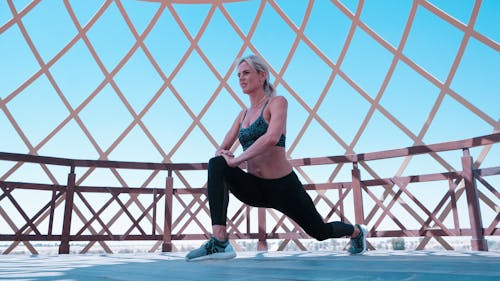
Lunges increase flexibility and help to contract the muscles in your legs. The lunge method is as follows:
a. Place your feet about hip-width apart as you stand.
b. With your right foot, advance forward while bending your front knee to a 90-degree angle.
c. Maintain a straight back and a tight core.
d. Return to the beginning posture by pushing up, then repeat with your left leg.
e. Execute 10 to 15 lunges on each leg while keeping good form.
Leg presses
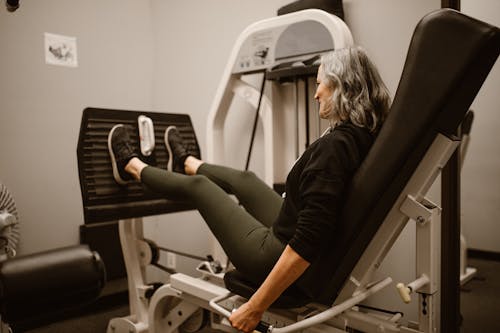
You can warm up and prepare your leg muscles for the workout by performing leg presses with or without weights. Below is how to perform leg presses without any special tools:
a. Put both of your feet flat on the ground while sitting on the edge of a bench or chair.
b. Lengthen your legs and drive through your heels to raise your body off the seat.
c. Hold for a short period while tensing your leg muscles.
d. Retract your steps back to where you were before.
e. Carry out 10 to 15 repetitions, paying attention to controlled motions.
Cool Down
Yoga Poses
Including yoga poses in your cool-down regimen will assist in calming your body, easing tension in your muscles, and increasing flexibility. Here are some yoga positions to try:
Child’s Pose
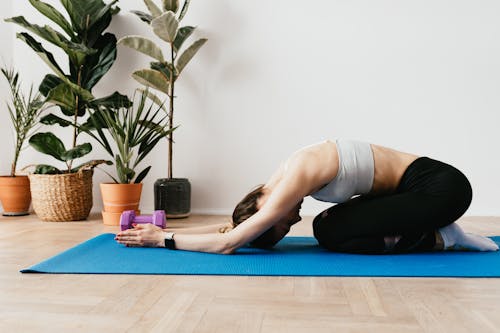
Kneel on the ground and take a seat with your heels back. Lower your upper body forward, raise your arms in front of you, and place your forehead on the mat. Take a few deep breaths and calm your body.
Downward Dog
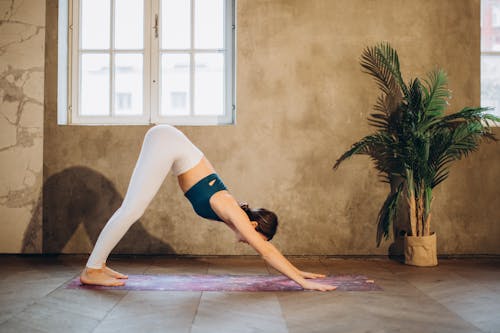
Begin on your knees and hands, and lift your hips upward and backwards, creating an inverted V shape with your body. Lengthen your legs, lengthen your spine, and press your palms into the ground. Your hamstrings, calves, and shoulders will all feel stretched.
Stretching exercises
Hamstring Stretch

Lie on the floor with one leg extended in front of you and the other leg bent with the foot resting against the inner thigh. Maintaining a straight back, slant forward from the hips and grasp for your toes. Repeat while changing legs.
Calf Stretch

Place your hands on the wall near your eyes while facing the wall. step behind your other leg, and position the leg you want to stretch. Bend your front knee while keeping the other leg straight and your back heel firmly planted on the floor. For 15 to 30 seconds, maintain the stretch.
Quad Stretch

Stretch your quads by standing tall and bringing one foot towards your glutes while holding the ankle with one hand. Feel the strain in your front thigh as you slowly draw your foot closer to your body. Continue on the opposite side.
Do not forget to breathe deeply while performing each stretch, holding it for around 20 to 30 seconds. Avoid any motions that make you feel pain or discomfort and pay focus on your body. During your workout’s cool-down, gradually let go of stress and allow your heart rate to return to normal.
What frequency and how much
How frequently per week?
Your fitness level, goals, and capacity for recuperation all affect how frequently you perform kettlebell leg workouts. To give your body time to adjust and heal, it is advised for beginners to start with 2-3 sessions per week. You can, if you’d like, gradually increase the frequency as you advance to 3–5 times weekly. Always keep an eye on how you feel and how well you recover between sessions while adjusting your schedule.
What Number of Sets and Reps?
According to your goals and stage of fitness, you may change the number of sets and reps you perform during your kettlebell leg workouts. Here are some general principles to think about:
a.Beginners should start with a minimum of three sets of each exercise and aim for 8 to 12 repetitions per set. Just before raising the weight or intensity, focus on maintaining appropriate form and technique.
b. Intermediate: Increase the number of sets to 3–4 for each exercise, aiming for 10-15 repetitions. To put your muscles through their steps, you can slightly increase the weight or intensity.
c. Advanced: Perform four to five sets of each exercise, aiming for 12 to 20 repetitions. To continue testing your stamina and power, utilise heavier kettlebells or introduce more challenging variations.
It’s vital to remember that the exact number of repetitions and rep counts may change depending on your unique skills and programme layout. Always put quality before quantity, and change the weight and number of repetitions according to your comfort level and form.
To achieve enough recovery and maintain peak performance during your workout, allow for adequate rest between sets, usually between one and two minutes. To enhance muscle recovery and prevent injury, always warm up correctly before each activity and cool down afterwards.
As always, it’s advised to speak with a trainer or fitness expert to create a kettlebell leg workout training regimen that is tailored to your individual requirements and objectives.
They may offer you individualised advice and make sure you’re following a secure and efficient training schedule.
Can you build legs with a kettlebell?
Yes, using a kettlebell to grow and strengthen your leg muscles is a great approach to getting in shape. You may strengthen your quadriceps, hamstrings, glutes, and calves by including exercises like kettlebell squats, lunges, swings, and deadlifts in your exercise regimen. This will encourage muscular development and improve your leg strength. Kettlebells are a flexible tool for leg development as regular use can help increase balance, stability, and explosive power.
Are kettlebell squats effective?
Yes, kettlebell squats are a great way to tone and build your lower body. Your quadriceps, hamstrings, glutes, and core muscles will be put to the test as you add resistance to the squat movement by holding the kettlebell near your chest or in a racked position. Squats with a kettlebell also work your stabilizer muscles and improve balance and coordination overall by requiring perfect form and technique.
Do kettlebells really burn fat?
Are kettlebell swings OK for knees?
Yes, if done correctly, kettlebell swings can be safe for the knees. Focusing on hip hinge mechanics is important, and excessive knee bending should be avoided. Increase weight gradually and pay attention to your body. Before beginning, speak with a professional if you have any knee concerns.
Related: Amazing Tips for Maintaining Fitness in Your 40s.
Using kettlebell leg workouts in your training programme has multiple benefits for your power, stamina, and appearance. Put safety and good form first, build up the intensity gradually, and concentrate on technique.
Yoga and stretching positions are good ways to cool down after doing exercises like squats, lunges, and leg presses to warm up. Pay attention to your body’s signals and give yourself enough time to recover.
Beginners should aim for 2-3 sessions per week, while advanced users should aim for 3-5. Ask an expert in fitness for advice. Kettlebell leg workouts will increase your strength, muscle tone, and functional fitness. Take pleasure in the task and benefit from it!
